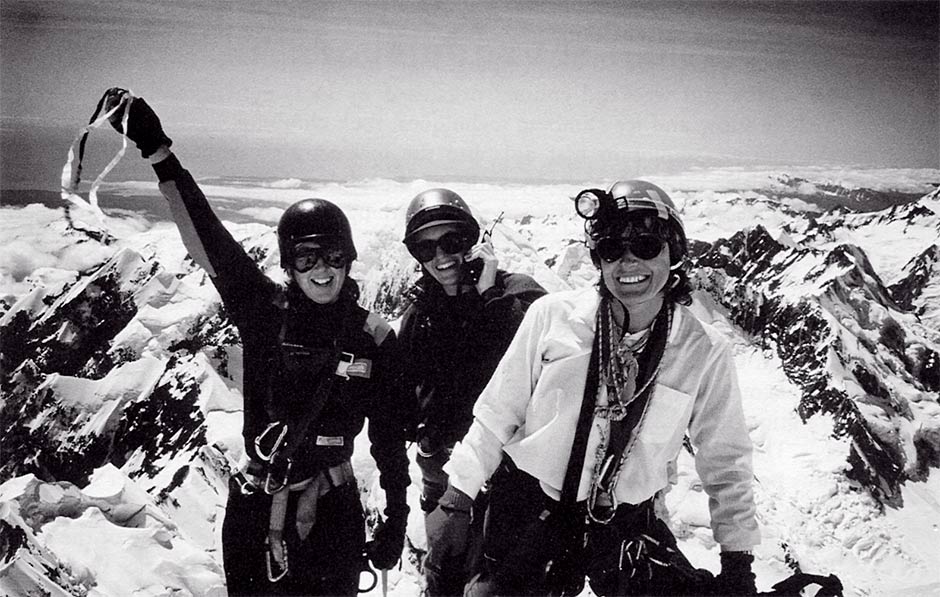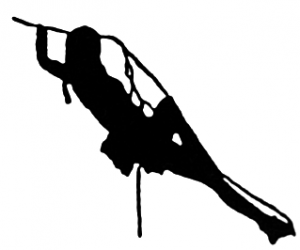This essay written by Jay Davison was first published in Women Together: a History of Women's Organisations in New Zealand in 1993. It was updated by Jay Davison in 2018.
1985 – 1993
Mountaineering is adventure, exploration and challenge. The rewards are achievement, self-knowledge, and the privilege of experiencing the high mountain world. Women Climbing was established to encourage women's participation in mountaineering, related alpine activities, and rock climbing (which by the 1990s was gaining in popularity as a separate sport), and to provide a communication network among women climbers. In 1992 there were 150 members, about half of them active in local networks in the main cities.
By the 1990s, while climbing was a high-profile and increasingly popular sport, it was still pursued by relatively few people, most of them middle class and Pākehā. Though always a minority in this traditionally male preserve, women played an integral role in New Zealand mountaineering history. They included exceptional climbers, from Freda du Faur — whose mountaineering activities, including first ascents in the Mt Cook region, defied Edwardian ideas of ladylike behaviour — to Lydia Bradey. Many more climbed in mixed groups of friends and in tramping and alpine club parties, where initiatives and decisions were invariably taken by the men.
In the 1980s, frustrated by these traditional gender roles and inspired by the women's movement, many women broke away to climb together. The different dynamics of all-women groups enabled them to develop confidence in their own skills and judgement. Some women, however, remained isolated from or unaware of other women climbers.
It was Dunedin climber Carol Nash who suggested a women's climbing network. Marilyn Staite of Christchurch had been inspired by American climber Arlene Blum's 1983 lecture tour of New Zealand on the 1978 American Women's Himalayan Expedition to Annapurna; in 1984 she began a recruiting drive, contacting women climbers throughout the country. Women Climbing was registered as an incorporated society in May 1985, with a founding membership of 70.
Nash outlined the aims of the new organisation in her milestone address, 'Women in New Zealand Mountaineering', at the Canterbury Mountaineering Club's 'Mountains '85' Conference:
to provide a network of information concerning people, contacts, literature, activities, instruction courses, gear sale – and to reach out into the community to encourage women. . . . We're ultimately aiming at being able to climb safely in the mountains with whoever [male and female] we wish. . . . It's not a splinter group, or an outspoken statement of feminism. [1]
Women Climbing networks in Christchurch and Wellington began meeting regularly and planning trips in 1985. By 1989 there were groups in Dunedin and Auckland, and women from Invercargill and Queenstown held joint instruction courses in 1990.
Early members identified a need for skills, confidence and knowledge beyond the basic levels usually taught in schools and clubs; it was at this more advanced level that they had often felt left behind by their male counterparts. Training courses thus became an important focus, with the first professionally instructed Women Climbing course being run at Mt Cook in 1987, funded by the Mountain Safety Council.
In the early 1990s over 60 women were taking part in the one-week course at Mt Cook, or in day and weekend courses organised by local networks. Topics covered included snow and ice climbing techniques, rock climbing, avalanche awareness, ski touring, mountain first aid, and the instructor's certificate. Although the emphasis was on improving the skills of those already climbing, local networks also ran introductory courses in rock climbing and mountaincraft, with experienced members as instructors.
Membership included professional mountain guides and instructors; active and experienced members of the New Zealand Alpine Club and other mountaineering and tramping clubs; and women just beginning their climbing careers. Women Climbing was also an important focus for its lesbian members. Members were encouraged in independent activities and in taking a higher profile within the traditional clubs.
The national co-ordinating role, initially undertaken by Christchurch, was by 1993 performed by a small Wellington group. It published a newsletter five or six times a year, and subsidised instruction courses from an annual grant made by the Hillary Commission. As climbing equipment was expensive, some of the grant was used to buy a small pool of gear for instruction and practice sessions.
Women Climbing received positive support from the New Zealand Alpine Club, and had links with the Pinnacle Club, the 1600-member women's climbing organisation in the UK. Locally, Women Climbing teamed up with like-minded groups such as Women Outdoors New Zealand/Aotearoa (WONZ) and women's recreation festivals, to encourage more women to participate in outdoor adventure.

Alison Douglass photo / Women Climbing.
Three of the six women who climbed Mt Cook (Aorangi) during the Summits for Suffrage celebrations, February 1993. From left: Sheila McKenzie, Sarah Wilson and Annette Richards.
In 1990, Women Climbing hosted two of India's leading women mountaineers, Bachendri Pal and Chandra Prabha Aitwal, arranging their lectures and taking them into the mountains. In 1992, Women Climbing's first international expedition of eight members, led by Margaret Clark, spent two months climbing and trekking in the Pindar region of the Indian Himalayas. On 13 February 1993, Women Climbing marked the inaugural day of Women's Suffrage Year with a series of simultaneous ascents throughout the country — a celebration of women reaching for high objectives. Over 4000 women took part in community-organised local climbs, and experienced women mountaineers headed for some twenty alpine summits, including New Zealand's highest peaks.
Jay Davison
1994 – 2014
Women Climbing had a short active life, from 1985 to around 2010. After the 1993 Summits for Suffrage event, it continued with its 150 members.
Alpine and other courses were funded by the Hillary Commission and Sport and Recreation to 2006. However, demand for women only courses had diminished, reflecting a decline of local groups. Some focussed on indoor wall-climbing, membership became more transient, and leading roles were not filled as experienced women left to care for families and/or careers, or simply felt they had done their stint. Women Climbing in some cases was seen an unnecessary alternative club rather than a network, and a national focus was lost. In 2018, only Christchurch Women Climbing remained as a small, informal but well-regarded way for like-minded women to network and climb together. Women Climbing Inc. was finally wound up and removed from the Incorporated Societies’ Register in 2014.
By 2018 there was evidence that women’s participation in mountaineering and rock climbing, high profile but minority activities, was increasing in line with social changes, as women made inroads into areas once considered ‘mostly male’. All-women climbing parties might be infrequent, but New Zealand Alpine Club (NZAC) membership was 30 percent women, up from 20 percent a few years earlier. Women could be almost half the participants in local courses at all levels (some courses might be specifically for women), and were active in other undertakings. Not all climbers, male or female, necessarily belonged to such organisations — outdoor pursuits centres and commercial courses also provided entry. Although indoor wall climbing had become popular, it might not transfer to the alpine world.
At the ‘top’ end, there were more professional women guides and instructors. Women could hold top jobs in the professional organisations and clubs. By 2018 two women had been NZAC presidents: Judith Reid (2005) and Penny Brothers (2015); and there were two current women life members of NZAC, Lydia Bradey (2011) and Margaret Clark (2016).
Leading women alpinists and rock climbers were continuing to achieve well in New Zealand and on the world climbing stage, and had been included in the NZ Alpine Team’s elite mentoring programme. It was fitting that Women Climbing members were involved in organising the 2010 centenary celebration of the first ascent of Mt Cook by a woman, Freda du Faur, held at Mt Cook Village; women made ascents of the mountain, including following Freda’s Grand Traverse.
Women Climbing filled a need for its time. Perhaps later generations of women climbers might review Carol Nash’s original concept for networking, in the light of contemporary needs and aspirations. In 2018 former members looked back on forging long lasting climbing friendships and the joy of meeting high and low challenges in the alpine wilderness.
Jay Davison
Notes
[1] Carol Nash, 'Women in New Zealand Mountaineering', paper presented to the Canterbury Mountaineering Club's 'Mountains '85' Conference, Christchurch, Easter 1985, edited version published in New Zealand Alpine Clubs Bulletin, Vol. 72 No. 3, October 1985, pp. 41–5.
Unpublished sources
Women Climbing Inc. annual reports, 1985/86–1991/ 92, printed each year in the national newsletter
Personal communications from and conversations with past Women Climbing members: Emma Bradley, Anna Carr, Alison Douglass, Jo Fox, Charlotte MacDonald, Robin Maxwell, Naomi O’Connor, Gilda Otway, Honora Renwick, Liz Thevenard, Pip Walter, Sarah Wilson; New Zealand Alpine Club members: Penny Brothers, Carolyn Ellis, Margaret McMahon; and also Laurence Fearnley, October–November 2018.
Published sources
Hair, Angela, 'Women Climbing', New Zealand Alpine Clubs Bulletin, Vol. 73 No. 4, December 1986, p. 24
O'Connor, Naomi, 'Now We Are Six', NZ Alpine Journal, Vol. 44, 1991, pp. 134–37
Women Climbing national newsletter (variously titled Women Climbing and Women Climbing Inc.), 1985–1992
See also:
Ross Digby Gore's Comic strip A woman conquers Mt Cook, 1957 and Freda Du Faur's historic and controversial ascent of Aoraki/Mt Cook in 1910.
https://teara.govt.nz/en/interactive/41825/ross-digby-gores-a-woman-conquers-mt-cook-1957


Community contributions